Reducing carbon emissions requires action from all of us – government, businesses and individuals. So here’s a quick guide on what you can do…
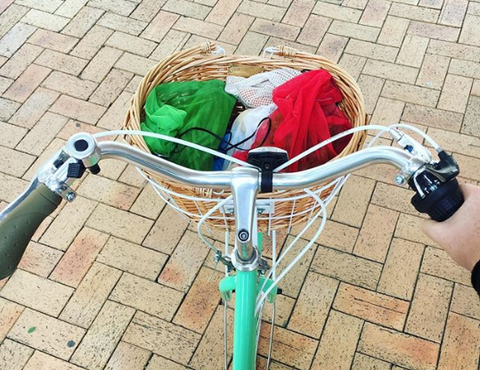
Ride Your Bike Is it a coincidence that Denmark is consistently ranked in the top 3 happiest countries and also has one of the highest per capita rates of cycling? Maybe, but they’ve also found that children who cycle and walk to school are much better at concentrating. The more people who cycle the safer it will be, so download a copy of Christchurch’s cycling maps and get on your bike (Also, Denmark and Christchurch are both flat, so we have no excuse!)
Support Local and Ethical Businesses If we want a world where businesses take responsibility for the environment, we have to support them. Shopping locally keeps money in the community and reduces carbon emissions and packaging. When you shop from ethical businesses your dollars are working all the way down the supply chain improving lives and the environment. To help you out, we've put all our NZ-made products on sale until the end of May.
Eat Less Meat. But this doesn’t mean you have to be vegan or even vegetarian, if we all switched to eating a Mediterranean diet (chicken a couple of times a week, beef once a month, and plenty of plant based foods) we could solve 15% of global warming by 2050! It’s equivalent of taking 1 billion cars off the road.
Switch to Reusables New Zealanders use 808,000 disposable coffee cups every year, wasting re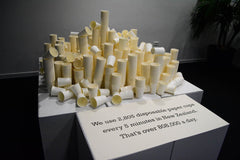 sources and emitting carbon. Reusable coffee cups are bulky and can leak in your bag – try a Stojo collapsible coffee cup which conveniently fits in your pocket or bag.
sources and emitting carbon. Reusable coffee cups are bulky and can leak in your bag – try a Stojo collapsible coffee cup which conveniently fits in your pocket or bag.
Speak Up – Fill in the CCC survey to let the council know how you are reducing your carbon emissions and how you’d like them to improve.
]]>
Plastic is lightweight and cheap, making it dangerously impactful on the environment. Think of a plastic bag and how much it resembles a parachute when it gets caught in the wind. Even if we don’t purposefully litter, we often unintentionally cause plastic to end up in the ocean. Here are some of the ways it happens and what we can do about it.

At the beach
At Cape Arnham in the Northern Territory in Australia footwear and jandals were found to be the most common item littering the beach. Jandals are inexpensive and when we think of them as disposable we neglect to look after them, often leaving them below the high tide line to be swept out to sea by the waves.
If every New Zealander loses a pair of sunglasses or jandals every year, there’s over 5 million plastic items straight into the sea.
Solution: Value your jandals as you would if they were expensive. Don’t leave any debris at the beach, including shoes, tents, plastic cutlery or cups.
Poor waste management systems
The majority of the countries that contribute to marine plastic litter are middle-income countries, where the economy is growing faster than the waste management infrastructure. However, New Zealand’s waste management systems aren’t perfect. Next rubbish day look at your street after the collection – there are always bits of plastic that have escaped as the wheelie bin is tipped into the truck.
Added to this, landfills aren’t sealed while they’re in use, so any loose plastic that is dumped can easily blow away. This plastic eventually ends up in the ocean.
Solution: Use a paper bin liner to make sure your rubbish is contained before putting it in the wheelie bin. Reduce your plastic consumption as much as possible to limit your rubbish.
Fishing gear
The largest contributor of plastic waste to the Great Pacific Garbage Patch comes from fishing equipment, amounting to a whopping 46% (by weight). These “ghostnets” keep drifting through the oceans entangling whales, dolphins and turtles. Whether or not you’re a commercial fisher, if you choose to eat net-caught fish you are supporting this practice.
Solution: Eat fish from the sustainable fish guide http://bestfishguide.org.nz/about/ to ensure you’re supporting safe fishing practices that do not harm ocean life. Look after your fishing gear, take it home and dispose of it correctly.
Microfibres
Every time we wash a fleece jacket it can release thousands of plastic fibres that are too small to be filtered out at sewage treatment plants. Studies indicate that synthetic fibres in our clothes could be poisoning our waterways and, by extension, the food we eat.
Solution: Wear natural fibres. Spot wash fleece and only machine wash them when absolutely necessary. Use face cloths and cleaning cloths made from natural fibres.
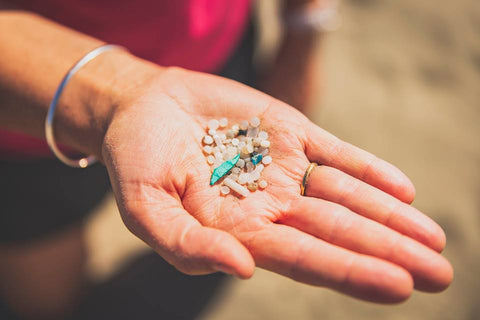
Manufacturing
Evans Bay in Wellington is covered with plastic ‘nurdles’ – the raw plastic beads or pellets used to make the products that we like to buy. These nurdles have escaped from the local manufacturers before they’ve even been made into anything useful, and have been described by environmentalists as “an oil spill, just a different form”.
The more plastic goods we consume, the more plastic is manufactured and the more nurdles are likely to escape into the ocean.
Solution: If we buy fewer plastic items, fewer nurdles will be created and land in our waterways. We’ll save money too, and space – you won’t have to Maree Kondoo your house!
Cigarette butts
Dropping cigarette butts is littering, and they go straight down the drains to the ocean. Cigarette butts are the most common item found on beach cleanups around the world, they’re made of plastic and do not biodegrade.
Solution: If you smoke, dispose of the butt in a responsible way. When you’re out use a pocket ashtray to keep the butt safe until you can dispose of it.
Littering
Ok, so we don’t litter but sometimes we accidentally drop a bottle lid, or ice-cream wrapper while we’re juggling the kids, the shopping and the car keys. If we all accidentally drop one piece of plastic every year, that’s five million pieces of plastic waste.
Solution: Accidents happen, so when you’re at the beach help others by picking up any rubbish you see. Download the app Litterati to make picking up rubbish into a treasure hunt – and join our Litterati club, named “The Rubbish Whisperer”, to add your total to ours!
]]>
Recycling soft plastics seemed like a silver bullet – we could eat the same packaged foods without feeling guilty about creating landfill waste, or ocean plastic pollution. But the problem with recycling being proposed and sold as a solution is that we all carry on consuming in the same way because "it can be recycled".
The Soft Plastic Recycling Scheme has taught us all a valuable lesson: most of the waste in household rubbish bins in New Zealand is likely made up of soft plastic.
 The scheme is planned for a return later this year but at a smaller scale which will leave most of the country’s soft plastics destined for landfill. So what can we do to reduce our soft plastic consumption? Donna Peterson from the waste management organisation WasteMINZ, asks "Do we actually really need to be using this amount of soft plastics? Are there alternatives out there that are actually better from an environmental perspective in terms of not creating waste in the first place."
The scheme is planned for a return later this year but at a smaller scale which will leave most of the country’s soft plastics destined for landfill. So what can we do to reduce our soft plastic consumption? Donna Peterson from the waste management organisation WasteMINZ, asks "Do we actually really need to be using this amount of soft plastics? Are there alternatives out there that are actually better from an environmental perspective in terms of not creating waste in the first place."
At The Rubbish Whisperer we love reusable alternatives to single-use plastics and want to help you begin ditching the soft plastic habit. So we’re putting our NZ-made reusable produce bags on sale until the end of Easter.
]]>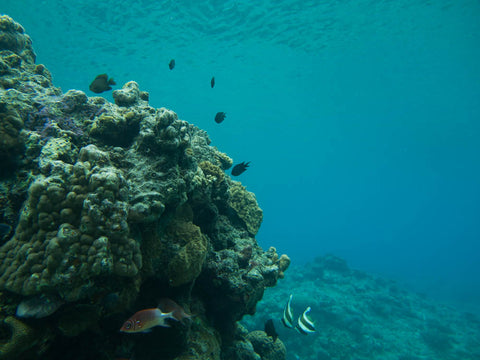
World Oceans Day will be marked this year on June 8th. This annual global celebration aims to help raise the profile of the ocean, highlight its importance in our lives and inspire more involvement to help to conserve this amazing resource, on which we all depend.
Since its inception in 2002, the global network of partners for the project has grown to include approximately 2,000 organizations that include, to name a few; aquariums, youth groups, sailors, governments, conservation organizations, educational establishments, the tourism sector and businesses.
This year NZ has several reasons to be smiling about its support of this awesome project. Firstly, the day before the event, the government will enforce regulations to ban the sale and manufacture of certain types of products containing plastic microbeads. Secondly, there are some great events taking place across the country to get involved with. To list or find out what is taking place near you, click on the link below: Events For World Ocean Day
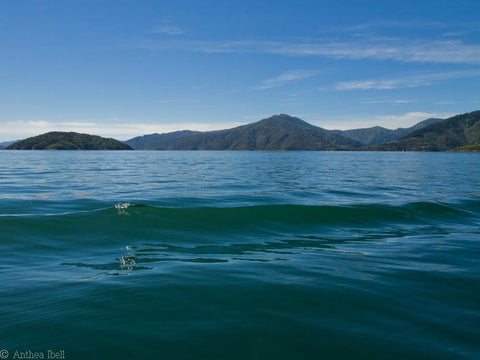
There are some motivated individuals, celebrities, community groups, organisations, businesses and political figures fighting to preserve the future of our seas; connecting to them through social media can offer valuable inspiration and facts to help fuel changes in our own lives. Here are our 6 Simple Steps To Help The Ocean Survive, with some links, to people already doing great things for the ocean:
- Pick It Up
One man’s healthy crusade to limit plastic in our oceans - Matt Akhurst aka therubbishrunner1 encourages us not to turn a blind eye to rubbish but to simply pick it up.
- Make Changes & Document Them
This simple project lead by a young generation of projectbluenz group of young NZ’ers changing the way they use single use plastics and documenting their journey, beautifully.
- Use Your Influence
Use your contacts and networks, just like leonardodicaprio, to spread the word. However small or large your sphere of influence you can.
- Collaborate To Find Solutions
theoceancleanup is a huge project marrying the best of technology, science and eco-change by experts across the world – their focus is the world’s largest clean up.

- Get Educated And Inspired
There are lots of collectives and organisations seeking to inspire and educate us towards change and earthmama.nz is just one NZ site where you can find well-presented facts and ideas.
- Go to the top
Our politicians get paid to listen to what their constituents want, need and believe. Connect with the PM jacindaardern or your local MP and ask them to get involved in promoting ocean friendly initiatives.
]]>The global consumer movement targeting single-use plastic straws is completely justified. Plastic straws are not recyclable and contribute significantly to manmade waste that ends up in landfill and litters our oceans. It is estimated that in New Zealand we use around 200 million plastic straws every year. In the United States, people use more than 500 million straws a day – that’s over 182 billion a year.
We are strong advocates for saying no to plastic by providing biodegradable and reusable straws. However, before we can change consumer behaviour, it’s important for people to understand the difference between common straw products and associated environmental impacts.

Plastic straws
Plastic straws have a short life-span as they are designed as a single-use product which we use to consume drinks before carelessly throwing them away.
It is a well-known fact that a single plastic straw can take up to 200 years to decompose. Even so, the negative environmental impact of plastic straws may come as a surprise given how small and thin the average straw is. Millions of straws end up in the ocean, where fish and marine mammals can ingest the plastic. Studies show that an estimated 71 per cent of seabirds and 30 per cent of turtles have plastic in their stomachs.
Plastic straws are made out of petroleum bi-product polypropylene, which is similar to the fuels we put into our cars. When straws begin to breakdown, they release harmful toxins that pollute the environment. When exposed to hot water or steam, plastic straws can easily melt and leak toxins.
To do your part to stop to the use of plastic straws is easy; don’t buy them in supermarkets and when ordering a drink, ask for a non-plastic straw.
PLA straws
PLA stands for polylactic acid which is made from renewable resources, such as sugarcane or corn starch. Naturally, one would assume that since PLA Straws are derived from natural ingredients that it would be better for the environment. However, this is not always the case and can often be misleading.
The issue with PLA straws is that people think they are buying an environmentally-friendly product. Although PLA is biodegradable, PLA straws and other PLA products become another form of plastic that will take years to breakdown in landfills and the ocean. PLA straws need to be composted under specific conditions and New Zealand does not yet have common facilities to compost PLA based products, forcing them to end up in landfills.
It is a common misconception that biodegradable PLA products are great alternatives to general plastic, however it is only great in theory as they still have a negative impact on the environment.

Paper straws
Paper straws are by far the most environmentally-friendly option. Paper straws breakdown quickly (they start to breakdown within three days if they end up in our oceans), and are compostable.
It is important however to research the brand or manufacturer before purchasing a paper straw product and check customer reviews.
There is a bit of controversy around paper straws as some brands use harmful chemicals when manufacturing the straw in order to overcome common complaints such as paper straws getting soggy too quickly or the colour of paper straws leaching into drinks. Paper straws are also slightly more expensive than the more commonly-used plastic straw, which are usually priced around $1.99 per bag in the supermarket.
However, if you buy better brands, such as those The Rubbish Whisperer sells, you will find that there was no need for plastic straws in the first place.
The Rubbish Whisperer only sells Aardvark-branded paper straws which are a suitable alternative to plastic because they quickly decompose and are user-friendly. Aardvark paper straws are 100 per cent Food and Drug Administration (FDA) and European Union (EU) approved, compostable with the ability to decompose in 30-60 days. They do not contain bees wax, are biodegradable and will not fall apart in your chilled drink. There is even a bendable paper straw option, which is great for hospital patients, people with physical disabilities and children.
While paper straws may cost a little more, the feel-good emotion you get from a refreshing drink will only get better when you know your straw won’t have a negative impact on the environment.
Stainless steel straws
Stainless steel straws are the way to go should you want to reduce plastic waste and help save the environment. Although the most expensive option when compared to its plastic and paper counterparts, you won’t have to buy another pack of straws again.
Stainless steel straws are made out of, as its name suggests, stainless steel. It’s the same material used to make common cutlery, so it is safe to use and chemical-free.
There are many reasons to use stainless steel straws, mostly because they are reusable and easy to clean, have a long-lifespan and are dishwasher safe. The Rubbish Whisperer sells its stainless steel straws with a custom-designed cleaning brush to effectively clean inside the straw and remove unwanted residue, which can be caused by fruit smoothies. Environmentally-friendly if it is continuously reused, and even better, passed on, stainless steel straws won’t impact the taste of the drink you’re consuming, look great at dinner parties, barbeques and events and they don’t create any more waste.
]]>